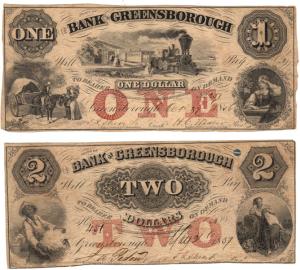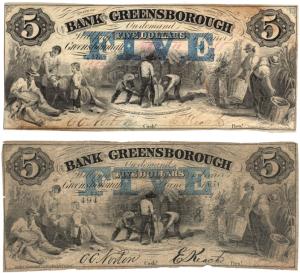Remember When the Bank of Greensborough Printed Its Own Cash?

During the Revolutionary War (1775–1783), money was needed to pay soldiers and to purchase food, guns, ammunition, uniforms and other military supplies. Consequently, the newly formed Continental Congress (soon to be the United States of America) issued paper currency to finance its participation in the war. Each colony, including Georgia, also issued currency to pay its bills.
Unfortunately, there was little gold or silver on deposit to guarantee the value of the currency, and by the time the war ended, the Continental and colonial currency still in circulation had become practically worthless. Because of the bitter experience with the devaluation of Continental and colonial currency almost as soon as it was issued, the public was strongly opposed to the further use of paper money.
Consequently, when the U.S. Constitution was drafted in 1787, it contained no provisions that permitted the federal government to print and issue paper currency; only coins with intrinsic value (gold, silver and copper) were allowed to be produced by the government. This requirement continued until passage of the National Banking Act of 1863, during the War Between the States, which made it legal for the U.S. government to print paper currency to finance that war.
During this 76-year period from 1787–1863, there rarely were enough coins in circulation in many areas to carry on business, and during hard times these coins were hoarded. Therefore, state and local governments and local businesses filled the need for a circulating medium of exchange in their areas by issuing paper money, and all the paper currency in circulation in the United States from 1787–1863 was supplied by states, counties, towns, banks, railroads, insurance companies, mills, factories, merchants and other private businesses. This practice was common in all regions of the United States, and there were hundreds of concerns in Georgia that issued paper currency at this time. One of these was the Bank of Greensborough, chartered in 1856 in nearby Greensboro, as it’s spelled now.
Wildcat Banks
Unfortunately, many of the banks that were opened in the mid-19th Century were not legitimate, and were operated for a short time for the express purpose of bilking the public out of money. Although many of these banks, including the Bank of Greensborough, probably started out as honest ventures by honorable men with honorable intentions, they did not end up that way.
These fraudulent banks often operated under a scheme called “Chicago Style” banking that was created by Northern con artists to deceive the public. The con artists opened banks in distant locations with local stockholders and elected local, respected men as bank officers. They put most of the bank’s currency into circulation in the North. Having the currency in circulation at a great distance made it difficult for individuals to redeem their bank notes and enabled the stockholders to reap large rewards before the currency made it back to its source for redemption. By the time it was discovered that the bank’s currency was worthless, the swindlers had absconded with the liquid assets of the bank.
These concerns often were referred to as “wildcat banks,” and there were several that operated in Georgia in the 1850s. Generally, they had beautiful, well executed bank notes printed by companies that specialized in printing currency, bonds and stock certificates; this helped make their operation look legitimate.
Thaddeus Brockett Rice gave a brief account of the Bank of Greensborough in his History of Greene County Georgia 1786-1886, and confirmed that the concern was dominated by outsiders. According to Rice, the original charter of the bank bore the names of some of Greensboro’s finest citizens, but some of these men died about the time the charter was issued, and they never actually opened the bank. He further stated that none of the men who actually did open the bank were natives of Greensboro, but were said to be adventurers from “somewhere in Yankeeland,” who were looking for an opportunity, and upon hearing the charter had been issued, came to Greensboro and bought or otherwise acquired the charter and proceeded to open and operate the bank.

The first currency issued by the bank appeared, bearing the date of Oct. 27, 1856. As with virtually all currency in circulation at this time, each note was individually signed, dated and numbered. Denominations included $1, $2, $5 and $10, with the values overprinted in large red block letters. Six months later, a second issue was emitted, identical to the first except for the dates of May 2 and 10, 1857.
In addition to the bank being taken over by Northern outsiders, 1856 was a bad year to open a bank because the next year a financial panic swept the nation, and many banks failed all over the country, including most of the banks in Georgia. The Bank of Greensborough was among the first of the Georgia banks to succumb. Almost exactly one year after opening for business, the bank closed.
The story should have ended here, but instead took an interesting turn. A few months after the bank’s closing, it was reorganized and reopened by another group of outsiders. To provide some credibility for their venture, Charles C. Norton, the deputy sheriff and local respected citizen who had conducted the sheriff’s sale the previous December, was brought onboard as cashier.

The new concern issued its first currency in May 1858. Bank notes were produced in the same denominations as before, with the denominations overprinted in large blue block letters instead of red, and all had handwritten signatures, dates and serial numbers. The notes were signed by C. C. Norton as cashier and E. Keach as president. Another issue of notes came out the next month, dated June 1, 1858. These notes also had blue overprints, but the signatures, dates and serial numbers were printed instead of being handwritten.
Apparently, the bank crashed again, Norton went back to work as a sheriff’s deputy, and nothing further could be discovered regarding the stockholders.
Funny Money
Again, it would appear that the story had come to an end, but not so! Next came the apparently fraudulent notes of J. A. Stevens and O. S. Stevens. According to Rice, they were brothers from Maine. Rice stated that they acquired the plates of the notes, had their names engraved on them as cashier and president, and issued bogus bills all over the country. Like the former issues, the notes exist in the denominations of $1, $2, $5 and $10, but without the red or blue overprints. They bear the printed date Dec. 7, 1858.
Despite what Rice said, there is some question as to whether the currency issued by the Stevens brothers was intentionally fraudulent or represented another attempt to revive the defunct bank. There is also some question as to whether they actually gained possession of the plates that allowed them to print the notes, because it is generally understood that the printers of currency at that time did not allow the plates of notes they printed to leave their possession. It is more likely that the Stevens brothers could have simply acquired sheets of unissued notes that were left over when the bank closed and added printed signatures, dates and serial numbers. Uncut sheets of the Stevens brothers’ notes exist, and of all the notes known to exist on the Bank of Greensborough, those bearing the signatures of the Stevens brothers are the most common.
The final story regarding the bank transpired 72 years later in 1930. During the Great Depression, a Chicago bank sent a $5 Bank of Greensborough note to the present Bank of Greensboro and inquired if the note had any value. The bank asked Rice, as county historian, to reply on its behalf. His response, in part, was as follows:
“We thank you for sending us the $5 note issued by the Bank of Greensborough on Dec. 7, 1858 for redemption.
“We are not disposed to figure the compound interest on the amount, but straight interest for 72 years at 8 percent per annum comes to $28.80, and the face value of the note being $5, brings the total up to $33.80.
“We do not believe in being close and stingy in a transaction of this kind; therefore we are going to show you how liberal we Greensboro people are by enclosing one $100 bill, one $20, one $10 and one $5 (in Confederate currency), making a total of $135 in full payment of the $5 note you sent us.”









comments